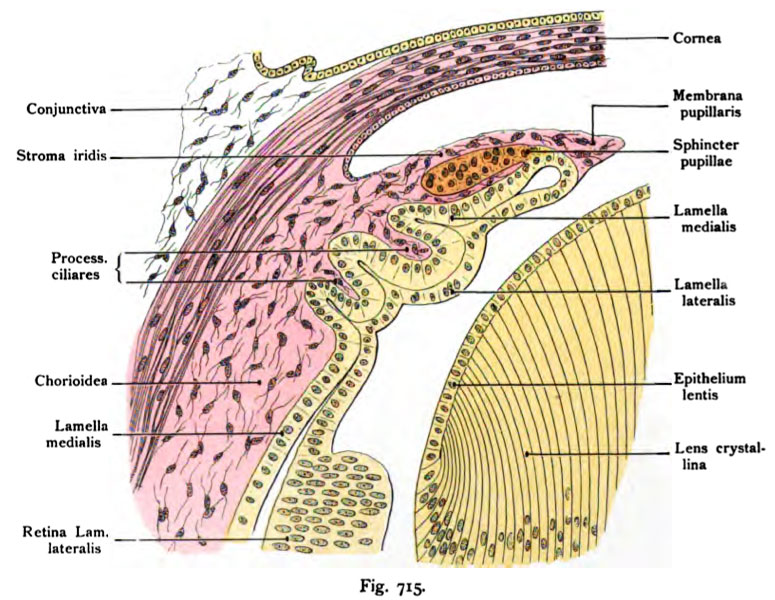File:Kollmann715.jpg
Kollmann715.jpg (775 × 600 pixels, file size: 128 KB, MIME type: image/jpeg)
- This text is a Google translate computer generated translation and may contain many errors.
Images from - Atlas of the Development of Man (Volume 2)
(Handatlas der entwicklungsgeschichte des menschen)
- Kollmann Atlas 2: Gastrointestinal | Respiratory | Urogenital | Cardiovascular | Neural | Integumentary | Smell | Vision | Hearing | Kollmann Atlas 1 | Kollmann Atlas 2 | Julius Kollmann
- Links: Julius Kollman | Atlas Vol.1 | Atlas Vol.2 | Embryology History
| Historic Disclaimer - information about historic embryology pages |
|---|
| Pages where the terms "Historic" (textbooks, papers, people, recommendations) appear on this site, and sections within pages where this disclaimer appears, indicate that the content and scientific understanding are specific to the time of publication. This means that while some scientific descriptions are still accurate, the terminology and interpretation of the developmental mechanisms reflect the understanding at the time of original publication and those of the preceding periods, these terms, interpretations and recommendations may not reflect our current scientific understanding. (More? Embryology History | Historic Embryology Papers) |
Reference
Kollmann JKE. Atlas of the Development of Man (Handatlas der entwicklungsgeschichte des menschen). (1907) Vol.1 and Vol. 2. Jena, Gustav Fischer. (1898).
Cite this page: Hill, M.A. (2024, April 27) Embryology Kollmann715.jpg. Retrieved from https://embryology.med.unsw.edu.au/embryology/index.php/File:Kollmann715.jpg
- © Dr Mark Hill 2024, UNSW Embryology ISBN: 978 0 7334 2609 4 - UNSW CRICOS Provider Code No. 00098G
Fig. 715. Sphincter pupillae bei einem menschlichen Fetus von 19 cm Länge.
Radiärschnitt durch die Cornea, Sclera, Iris, Linse und die naheliegenden Teile. Vi« Ölimmersion. Das Pigment in der medialen Lamelle der Augenblase ist entfernt Der Musculus sphincter pupillae geht aus den epithelialen Zellen der Umbiegungsstelle der beiden Blätter der sekundären Augenblase hervor. Er stellt ein Band dar, das auf dem Radiärschnitt wie ein kolbenartiger Fortsatz sich erhebt und von dem Irisstroma umgeben wird. Später löst sich der Fortsatz von dem Epithel ab. — Auf der Abbildung sind noch andere für die Entwicklungs- geschichte des Auges wichtige Einzelheiten erkennbar : die Anlage der Ciliarfort- sätze, das Irisstroma, die Fortsetzung desselben in die Membrana pupillaris, die nach kurzem Verlauf abgeschnitten dargestellt wurde. Ferner ist sichtbar die Verdickung des Pars ciliaris retinae in die Pars optica und die Conjunctiva bulbi, deren Epithel in das Epithel der Cornea übergeht, gelb tingiert wegen der Herkunft aus dem Ektoderm wie die sekundäre Augenblase.
File history
Click on a date/time to view the file as it appeared at that time.
| Date/Time | Thumbnail | Dimensions | User | Comment | |
|---|---|---|---|---|---|
| current | 10:49, 21 October 2011 |  | 775 × 600 (128 KB) | S8600021 (talk | contribs) | {{Kollmann1907}} Category:Vision Fig. 715. Sphincter pupillae bei einem menschlichen Fetus von 19 cm Länge. Radiärschnitt durch die Cornea, Sclera, Iris, Linse und die naheliegenden Teile. Vi« Ölimmersion. Das Pigment in der medialen Lamel |
You cannot overwrite this file.
File usage
The following 2 pages use this file:

